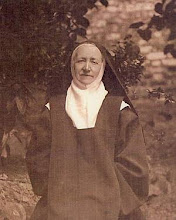Various Carmelite institutions
Several religious institutions have gathered round Carmel. In the Middle Ages we find attached to many convents and churches anchorages, that is, hermitages for recluses who at their own request were walled up by the bishop and who exercised a great influence over the populace by reason of their example, their austerities, and their exhortations. Among the more celebrated Carmelite recluses may be mentioned Thomas Scrope of Bradley, at Norwich, afterwards titular Bishop of Dromore in Ireland and Apostolic legate in Rhodes; and Blessed Jane of Toulouse (beginning of the fifteenth century) whose cultus was approved by Leo XIII.
Probably ever since the coming of the friars to Europe, founders of convents and benefactors were admitted to the order under the title of Confratres, which gave them a right to participation in the prayers and good works of a section or of the entire order, and to suffrages after their death. Neither such Confratres, nor even the text of confraternity letters, contain any mention of obligations incumbent on them. The letters were at first granted only after mature consideration, but from the end of the fifteenth century it was less difficult to obtain them; in many cases the general handed numerous blank forms to provincials and priors to be distributed by them at their own discretion. Out of this confraternity, which stood in no organic connection with the order, arose in the sixteenth century, according to all probability, the Confraternity of the Scapular.
Another confraternity was a guild established in 1280 at Bologna, and perhaps elsewhere, which held its meetings in the Carmelite church and from time to time made an offering at a certain altar, but otherwise was entirely independent of the order. As has been seen, some communities of Beguines in the Netherlands asked, in 1452, for affiliation to the order, and thus gave rise to the first convents of Carmelite nuns. At a later period Herman of St. Norbert (died 1686), preaching in 1663 at Termonde, determine five Beguines, among them Anne Puttemans (died 1674), to sell their property and found the congregation of Maricoles or Maroles, which was aggregated to the order 26 March, 1672; they occupy themselves with the education of poor girls and with the care of the sick in their own homes, and have still many convents in the Dioceses of Mechlin, Ghent, and especially Bruges. A community of thirty-seven hermits living in various hermitages in Bavaria and the Tyrol having asked for aggregation, the General Chapter of the Discalced Carmelites of 1689 granted their wish under certain conditions, among others that not more than four or five should live in each hermitage, but the decree was rescinded in 1692, for what reason is not known, and all connection between these hermits and the order was severed.
Carmelite tertiaries
Tertiaries or members of the Third or Secular Order may be divided into two classes, those living in their own homes and those living in community. The former class is first met with in the middle of the fifteenth century, when the Holy See granted permission to the Carmelites to institute a Third Order of secular persons, after the model of similar institutions attached to other mendicant orders. The oldest printed Missals and Breviaries contain the rite of admission of such persons; these were then known by the term of bizzoche, which has since acquired a somewhat unpleasant meaning. They were found to recite certain prayers (in the Teresian Reform also to practice meditation), to keep certain fasts and abstinences, refrain from worldly amusements, and to live under obedience to the superiors of the order; they might wear a distinctive habit resembling that of the friars or nuns. Tertiaries living in community observe a rule similar to, but less austere than, that of the friars; there are two communities of Tertiary brothers in Ireland, one at Clondalkin, where they have a boarding-school established previous to 1813, and another, in charge of an asylum for the blind, at Drumcondra near Dublin. There are also Tertiary fathers (natives) in the Archdiocese of Verapoly in India, established 1855, who serve a number of missions.
Tertiary sisters have a convent in Rome founded by Livia Vipereschi for the education of girls; they were approved by Clement IX in 1668. The Austrian congregation has had, since 1863, ten houses partly for educational purposes, partly for the care of servants. In India, too, there are native Tertiary sisters in Verapoly and Quilon with thirteen houses, boarding schools, and orphanages. A Tertiary convent was founded in Luxemburg in 1886. Finally, mention must be made of the Carmelite Tertiaries of the Sacred Heart lately established in Berlin, with orphanages and kindergartens in various parts of Germany, Holland, England, Bohemia, and Italy.
Statistics
At the present time (1908) there are about 80 convents of Calced Carmelite friars, with about 800 members and 20 convents of nuns; 130 convents of Discalced Carmelite friars, with about 1900 members; the number of convents of nuns, including the French previous to the passing of the Association law, was 360.
18 May 2011
Subscribe to:
Posts (Atom)
